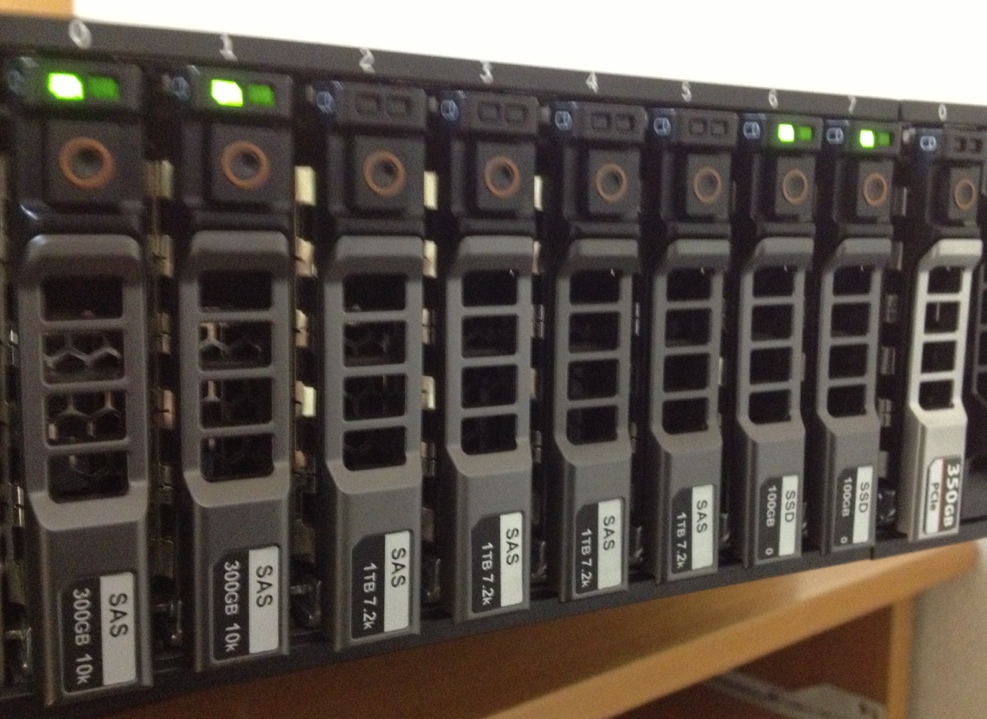Dell PowerEdge PCI-E SSD
Today, we will continue to explore various PCI-E SSD- based storage solutions (a computer bus using a PCI software model of the bus and a high-performance physical protocol based on serial data transmission). We offer you a brief standard synthetic tests of this disk drive.
Dell's solution is structurally different from the OCZ Z-Drive R4 and Fusion-io ioDrive Duo that have already been with us. It is a Micron PCI-E controller board .

Each port is “single channel”, that is, only one drive can be connected to one port.
')

The drive (also produced by Micron) is made in the 2.5 "form-maker with the SAS interface.

The volume of drives can be equal to 175, 350 or 700 GB. The controller supports the hot-swap feature, but it's not entirely clear why this is needed, since it does not support RAID of at least some level (only soft-raid using the system tools). As can be seen in the picture, we have a second-generation module for 350 GB SLC memory. We got this system bundled with the Dell PowerEdge R820 server , and the controller was already connected to the basket for four such drives (although the drive only got one, although in any case we wouldn’t test using soft-raid).


The basket itself is different in appearance only by the inscription “PCI-E SSD”.
On the Dell site, there is practically no information about the system, but the Micron site gives a little more information.

Characteristics, as always, are pleasing to the eye, but we have become accustomed to the fact that these indicators were obtained in laboratory conditions, which are almost impossible to achieve in real life.
Well, let's move on to the tests.
AIDA64 Disk Benchmark


We received such an interesting picture by running the test for the first time. Here, in general, everything is clear: the lack of support for TRIM. Already used drive gave a quite predictable result.
But what happened after 10 minutes of machine downtime:




Crystaldiskmark

ATTO Disk Benchmark

AS SSD

And especially for fans of IOPS `


findings
Pros:
The fairly low cost of 1Gb of disk space compared to competitors.
This drive can be bootable, that is, you can install the system on it and use it as a single drive in the PC / server. Not all PCI-E SSD drives can boast that.
SLC NAND.
The possibility of expanding and increasing the volume.
Hot-swappable drives.
Minuses:
Fairly average speeds.
No hardware RAID support.
As a result, we have a drive that is rather interesting in its design features, which has very good scalability, but also has the disadvantage of not having a hardware RAID. What stops the developers from its introduction is unknown, because such a solution could be very popular. As for the speed characteristics, they do not show anything outstanding, but this solution cannot be called an outsider either. In the meantime, we can only observe where this direction of disk drives will develop.
By KorP
Dell's solution is structurally different from the OCZ Z-Drive R4 and Fusion-io ioDrive Duo that have already been with us. It is a Micron PCI-E controller board .

Each port is “single channel”, that is, only one drive can be connected to one port.
')

The drive (also produced by Micron) is made in the 2.5 "form-maker with the SAS interface.

The volume of drives can be equal to 175, 350 or 700 GB. The controller supports the hot-swap feature, but it's not entirely clear why this is needed, since it does not support RAID of at least some level (only soft-raid using the system tools). As can be seen in the picture, we have a second-generation module for 350 GB SLC memory. We got this system bundled with the Dell PowerEdge R820 server , and the controller was already connected to the basket for four such drives (although the drive only got one, although in any case we wouldn’t test using soft-raid).


The basket itself is different in appearance only by the inscription “PCI-E SSD”.
On the Dell site, there is practically no information about the system, but the Micron site gives a little more information.

Characteristics, as always, are pleasing to the eye, but we have become accustomed to the fact that these indicators were obtained in laboratory conditions, which are almost impossible to achieve in real life.
Well, let's move on to the tests.
AIDA64 Disk Benchmark


We received such an interesting picture by running the test for the first time. Here, in general, everything is clear: the lack of support for TRIM. Already used drive gave a quite predictable result.
But what happened after 10 minutes of machine downtime:




Crystaldiskmark

ATTO Disk Benchmark

AS SSD

And especially for fans of IOPS `


findings
Pros:
The fairly low cost of 1Gb of disk space compared to competitors.
This drive can be bootable, that is, you can install the system on it and use it as a single drive in the PC / server. Not all PCI-E SSD drives can boast that.
SLC NAND.
The possibility of expanding and increasing the volume.
Hot-swappable drives.
Minuses:
Fairly average speeds.
No hardware RAID support.
As a result, we have a drive that is rather interesting in its design features, which has very good scalability, but also has the disadvantage of not having a hardware RAID. What stops the developers from its introduction is unknown, because such a solution could be very popular. As for the speed characteristics, they do not show anything outstanding, but this solution cannot be called an outsider either. In the meantime, we can only observe where this direction of disk drives will develop.
By KorP
Source: https://habr.com/ru/post/165191/
All Articles